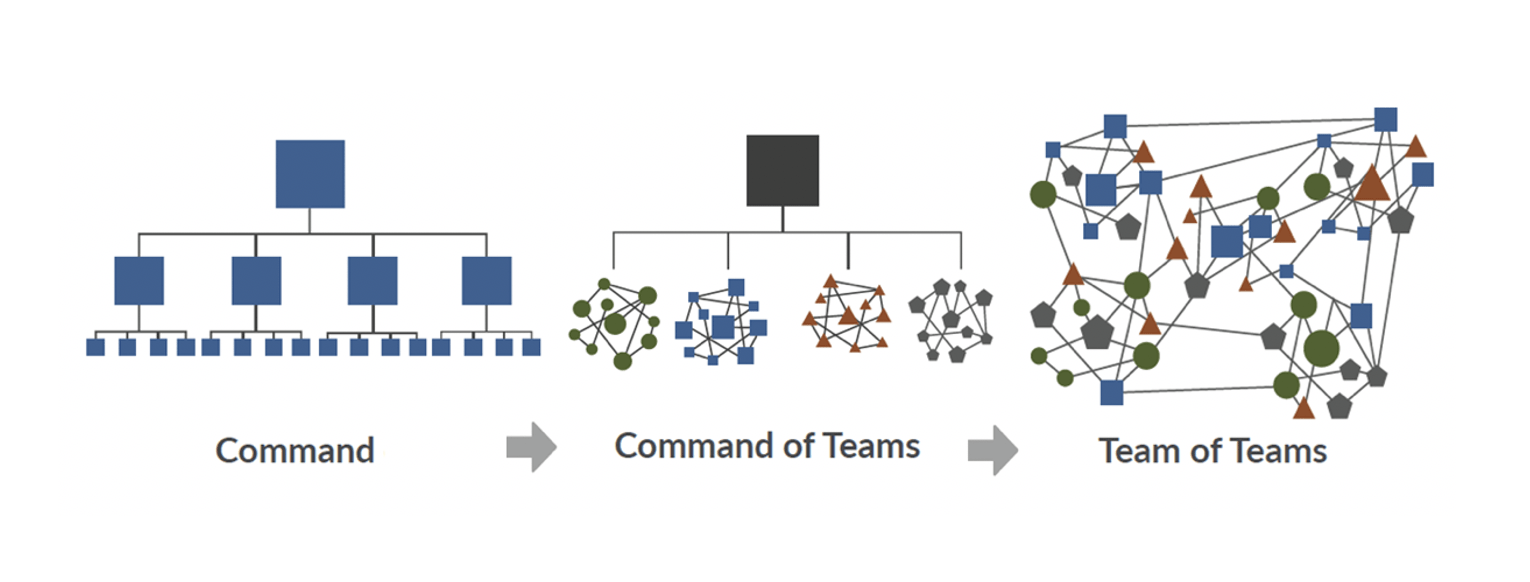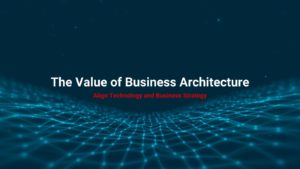THE TEAM WITH THE BEST LEADERSHIP WINS.
This is the seventh part of an ongoing series, where I’m using the framework of WHY, WHAT, HOW, WHO from my book Blind Spot: A Leader’s Guide To IT-Enabled Business Transformation – enhanced with stories and analogies – to help business leaders to understand the Digital and IT transformation journey in very simple business terms.
The crisis of the last few months should have clarified WHY we need to change, and that the time is NOW (Part 1). Only a few senior leaders are still wondering about or resisting that premise. One real challenge, for the entire executive team, is to think about WHAT will make us faster and more flexible, which is “Business Agility” (Part 2). Of equal importance this time, HOW we architect and build modern systems matters – a lot – because we can’t have Business Agility if we keep adding to our Technical Rigidity. And, in order to build it right and see the Business Agility value come to fruition, we have to finance and manage our IT investments the right way. HOW we architect and build systems is deeply connected to HOW we invest in IT. Together Part 3 and Part 5 of this series explain the history and problems created; Part 4 and Part 6 propose a new and better way forward.
The final two parts in this series, this Part 7 and an upcoming Part 8, will be about the WHO. In a world that is this dynamic and within a company that is innovative, the structure, leadership, culture, and workforce need to be continuously learning, leading, and adapting. You can’t have Business and Technical Agility if you have Organizational Rigidity or weakness.
Part 7: The WHO – Structure, Leadership, Culture, Workforce
As this digital revolution hits full stride – and now accelerates post-COVID, success in the global marketplace will depend on an organization’s ability to implement new innovative technologies rapidly and at scale. Increasingly, these technologies will be embedded and pervasive. They will come at us in non-traditional form factors like robots, sensors, watches, engines, etc. As they become integrated into the fabric of our day-to-day Operation and Customer Experience, seamlessness, reliability, scalability, and resilience must be properly architected and engineered. Therefore, winning in the 21st century will depend on Information Technology competency, continuous modernization, and alignment between a dynamic Business Model and flexible Systems Architecture.
A Leadership Team Without “Blind Spots”
The “Blind Spot” between business and IT leaders needs to be eliminated. It’s hard to imagine a successful enterprise 10 years from now where the business leaders aren’t technology “savvy” and the technology leaders aren’t business “savvy”. In many cases, companies will spend hundreds of millions, or even billions, of dollars on initiatives to reinvent their business and information systems. However, many businesses under-think and under-invest in the leadership and organizational competencies required to continuously reinvent a company. I’ve learned over the years and during the course of numerous systems transformations that getting the “architecture of change” and enabling the “right leaders” is critical to successful and sustainable results. The payoff for having a leadership team that is well respected and can traverse the “Blind Spot” between business speed and innovation and the technical possibilities of this Digital Era has never been more profound.
Most new value creation and competitive advantage will no longer come from functional systems improvement. That’s just table stakes. Most leverage will be enabled by cross-function and cross-business-unit and even cross-corporation/supplier (ecosystem) solutions. Becoming great at technology integration is now critical and every executive team must find innovative solutions that do a better job of serving their customers and controlling costs and managing their supply chains and nimbly responding to marketplace conditions and out-thinking and out-executing the competition. More and more these solutions are digital and have technology and process at their core and would rightly flow and be championed by business leaders. Those business leaders must be lateral thinkers and advocates for horizontal relationships and integration across traditional departmental or business unit silos.
These cross-over leadership competencies – business and technology, cross-functional integration – are easy to find in companies that were born in the digital era. There is a seamlessness between commercial, operational, financial, people, and technology leaders. In fact, to the casual observer of a startup or digital native executive team meeting, it might be hard to distinguish the CEO from the CMO or the CFO or CIO. That’s not so true in most established Fortune 500 companies. And, that’s a key problem to be solved.
Developing A “Continuous Transformation” Organization Model
In the 20th century, the most successful companies were always in a state of “continuous improvement” (Six Sigma, Industrial Engineering, TQM, etc.). In this century, those capabilities alone won’t get it done; it’s not enough anymore. Going forward, we need to be in a state of “continuous transformation”. New business models are at the intersection of imagination, advancing technologies, innovation, and always evolving customer and employee expectations.
These were the core beliefs of Wayne Calloway, who was Chairman and CEO of PepsiCo during the 1980s-90s, and a great mentor to me in my time as the CIO of Frito-Lay (a division of PepsiCo). Here’s a video of him from the 1990s.
During Wayne’s tenure, we doubled our revenue every 3-4 years and maintained double-digit profit growth. Wayne’s leadership formula was simple; he said a great leader does three things well: Sets the Agenda, Builds a Great Team, and Delivers with Consistency. Wayne’s formula required strong financial and talent management.
Finance’s power and importance were obvious because, as a growth company, we were always making big investment bets on new products, acquisitions, more manufacturing plants, and route expansion. In addition, sustained growth required aggressive recruiting and great talent and leadership development, driven by a strong, forward-leaning HR team. It was always clear at PepsiCo/Frito-Lay that the company with the strongest financial resources and the best talent always wins.
For more about Wayne and his leadership principles, see my book called The Calloway Way, Results & Integrity.
In the 21st century, we now have to add world class technology leadership. To PLAY this game, the CIO needs to be a force for engaging all other CXOs. To WIN this game, and THRIVE going forward, the CIO, CFO and CHRO have got to be BEST FRIENDS because those leaders are the stewards of the technology, money, and people – which are the big levers for driving change.
It may seem impossible to find “broad “and “deep” individuals who combine such exceptional talents and attributes, but they can be developed. It’s the special and critical responsibility of the CEO, CIO, and CHRO to make this happen. We’ve got to begin to invest in our high-potential technology-savvy and integration-savvy business leaders through rotation across the business, mentoring and executive coaching, and the renaissance of more formal Leadership Development programs that dominated the 80’s and 90’s. We also need to redefine the modern corporation’s Organization Model, including roles and responsibilities between business, technology, and innovation leadership. Let’s focus on four components of the Organization Model – Structure, Leadership, Culture, and Workforce.
Organization Model: Structure
Organization Models traditionally have been functional, geographic or line-of-business centric. And, they have been either centralized or decentralized, which is too simplistic and coarse grained. Over time, we have begun to transform many organizations to be more customer-centric, with a global reach and a leveraged supply chain and operation. However, functions, geographies, and business units have uniqueness and still matter. This has created complex matrices. Role definitions at these intersections are seldom properly debated and explicitly resolved. This has created turf battles and gaps that have impeded progress in these highly integrated global organizations.
In a modern structure, deciding which CAPABILITIES need to be common vs. which can and should remain unique (whether by line-of-business or function or geography), should inform our approach to organization. It also informs which business capabilities should be planned and implemented once and then leveraged at the core, and what is better done at the edges. This creation of a “matrix system” then can inform the roles and responsibilities, and, therefore, the decision rights and resolution paths when there are conflicts. As we work to enable agility and adaptability into our businesses, this set of decisions about which business and technical capabilities are common and which ones are unique has become more important. To get strategic, cross-functional Business and Architectural Outcomes, we can be easily tempted by the compelling logic to make more things more common across the enterprise. On the other hand, allowing the right degree of unique autonomy and customization or specialization by department, business unit and/or geography could also be critical to customer/market intimacy, efficient operations, quick market response/competitiveness, and executive accountability. Making the right decisions, finding the “sweet spot”, should drive the organization structure.
Role clarity, decision rights, and governance are all particularly critical around cross-functional and cross-business-unit roles, like the emerging Chief (Customer, Data, Marketing, Logistics, etc.) Officers and especially the Chief Digital, Chief Innovation, Chief Technology and Chief Information Officers. In fact, we should seriously examine how many “Chiefs” does a modern organization really need when all of the weight will continue to fall on the business unit leaders that own the P&L.
The right CIO, who sees their role as Chief INTEGRATION Officer, not merely Chief Information Officer, should be responsible to engineer the solid leveraged core and encourage and enable the flexible edges. Alignment on this architectural mindset allows for connection to data and events into a durable infrastructure, or core, that is well engineered for scale, resiliency, durability, and security (like the interstate highway analogy and the Delta Nervous System in Part 4B of this series). Its design also needs to enable innovation at the edge, and speed to market through configuring and deploying solutions that integrate packages, sensors and legacy into new capabilities, versus massive programming efforts (like the state and local roads analogy and the Delta Gate & Boarding system in Part 4B of this series). This enablement or Chief Integration role is different from how the role was previously viewed. The CIO can no longer, nor should he/she, control all things technological. Role clarity, decision rights, and accountability are critical and very consistent with balancing scalability and security with new innovative ideas at the edge.
For more a more detailed discussion of Structure, see STRUCTURING A WORLD-CLASS IT ORGANIZATION.
Organization Model: Leadership
If you buy the argument that technical, engineering, imagination, collaboration and selling skills are critical to building a great technology-enabled digital enterprise, then all members of a modern executive team need to possess all five of these attributes – however, not necessarily at the same level of competency.
For example, the CMO, CFO, and other members of the leadership team all need to be technically savvy, but they do not need to possess the engineering depth that the CIO would require. By the same token, the CIO may not know as much about Marketing, Finance or Operations as would be the case for the CMO, CFO, or COO, but the CIO and CHRO still would need to be interested in learning and knowledgeable about the issues and possibilities in each area. More importantly, the CIO, CFO, and CHRO need to understand the enterprise as a “system” and be able to weave a “fabric” between functions while being responsible for integrating Commercial go to market activities with Operations, and Back Office capabilities in a harmonious but flexible way. These must be smooth and seamless for customers, employees, and suppliers. Realistically speaking, that’s usually not anyone’s job in a global, functional organization except the Chief Integration Officer (CIO), Chief Financial Officer (CFO), and the Chief Human Resource Officer (CHRO).
For a more detailed discussion of additional Leadership competencies, see LEADERSHIP MATTERS MOST.
Organization Model: Culture
As the Structure and Leadership discussions make clear, one can’t define the roles and responsibilities or write enough rules to cover every circumstance in these complex models. By definition, a matrix creates significant dependencies and therefore, leaders have got to “show up” for each other. A culture of trust, accountability, openness, and integrity is what really matters. Enabling freedom for business and IT teams to work together on the edges will foster speed, innovation, and agility. But control and discipline are also required, especially at the core, so we can convert the speed and innovation into customer delight and sustainable, profitable growth. This tension can only be resolved by a cohesive, leader-led culture where leaders can be trusted to work for the greater good of the whole because they embrace the ideas and the vision, and not simply because they will be punished if they over-reach or break “the rules”.
Organization Model: Workforce
In the end, this is a technical business that requires planning, designing, coding, testing and running. We have to Deliver with Consistency (see Wayne Calloway’s simple formula above). In this Modern Era, when business models and operations are becoming totally dependent on the “digital fabric”, the technology has to be 100% resilient, scalable, and secure. An organization must have the right mix of skills, levels, roles and competencies. It’s not about having more people. Sometimes we may have too many people. If they are the wrong people or the wrong mix (too many of this and not enough of that), it can be very difficult to be productive or deliver at all. It’s about having great people in the right mix and doses.
The IT team needs to change and evolve. We need to be able to protect and retain the domain and legacy systems knowledge that got us to where we are today. That knowledge is also required to help us modernize and continue to get value from our legacy portfolio of applications. While we’re doing that, we need to be great at new technology, and we have to make sure we are getting the RIGHTS right – right skills, right mix, right size, right place, right cost. Just as our business and our technology are on a transformational journey, our IT workforce and culture are also on a journey. We need that partnership with HR to help us Build a Great (IT) Team or the transformation will never get traction.
Even once the IT team can deliver new technology, that’s only part of the transformation. Remember, just changing the technology and processes won’t achieve real or sustainable outcomes unless the workforce changes too. The technology, if it’s truly transformational in its impact on the business model, will create huge shifts in the WHO, WHAT, HOW, WHERE, and WHEN work happens. This is now vividly clear and rapidly accelerating. There is a larger (more than just IT) workforce and cultural transformation required to compete in the future. For this, we also have to partner with HR leadership to help make it happen across the entire business. I’ll dedicate all of the upcoming Part 5B of this series to that larger workforce transformation.
Conclusion: The Who Is Where All the Leverage Is
Although business is not war, there is something to be learned from how the military has had to adjust Structure, Leadership and Culture from World War I to today as both military and information technology have changed the landscape. The evolution that Stanley McChrystal describes in his book Team of Teams: New Rules of Engagement for a Complex World is not dissimilar from our evolution from Industrial Era Organization Model to the Digital Era.

To make this shift in the executive and functional leadership teams will take some time and effort, as well as sustained investment in developing a 21st century, technology-enabled organization. However, it must be done. The old models have run aground. Fads will come and go, but there is no alternative to real competency. Building organizational muscle and skills to compete in the future needs to be a Board and Executive Committee imperative. We should not underestimate the importance of leadership, competency and culture in general. And, specifically, it can be fatal to undervalue the critical roles that the CIO, CFO, CHRO, and the other “Game Changers” (the influential drivers of change) must play in a modern enterprise. This is an extra heavy lift because established companies are burdened with 40 years of legacy systems and culture that must be deconstructed, modernized or replaced. However, these issues are positively offset by significant assets such as brands, global reach, capital and strong functional expertise that emerging competitors may lack. What a great time to develop the next generation of CXO’s who can lead the “Digital Transformation”. This next decade will certainly sort who will survive and thrive and who will become extinct. Getting the Structure, Leadership, Culture, and Workforce right is the key.
This can feel as daunting as moving the world. Archimedes said, “Give me a lever long enough and a fulcrum on which to place it, and I shall move the world.” I believe that our leverage on this move-the-world kind of challenge is the WHO – and especially the Leadership. Find and develop the best leaders, continuously work to develop your leaders, and they will make the rest happen.
Author: Charlie Feld, Founder and CEO, The Feld Group Institute
Further Learning
If you are interested in learning more about this topic, additional resources can be found on our site. Including the following articles from our Leading The Acceleration of Digital Transformation series.
- Part 1: WHY the Time Is Now
- Part 2: The WHAT Is Business Agility
- Part 3: Changing HOW the Technology is Built
- Part 4: HOW We Build IT to Last by Designing for Change
- Part 5: HOW Accounting Practices Shaped Our Legacy IT “Hairball”
- Part 6: HOW Do We Get The Value For Our Investments?




